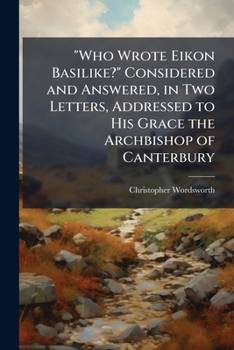"Who Wrote Eikon Basilike?" Considered and Answered, in Two Letters, Addressed to His Grace the Archbishop of Canterbury
In "Who Wrote Eikon Basilike?" Considered and Answered, Christopher Wordsworth delves into the historical controversy surrounding the authorship of the influential book, "Eikon Basilike". This work, purportedly written by King Charles I during his imprisonment, was published shortly after his execution and played a significant role in shaping public opinion of the executed monarch.
Wordsworth addresses his investigation in the form of two letters to the Archbishop of Canterbury, meticulously examining the evidence and arguments for and against Charles I's authorship. This detailed analysis provides valuable insight into the political and literary climate of the 17th century, as well as the enduring power of propaganda and the manipulation of historical narratives.
This volume offers a fascinating glimpse into a pivotal moment in British history and the ongoing debate surrounding a text that continues to captivate historians and literary scholars alike. It remains a vital resource for anyone interested in the complexities of historical truth and the legacy of Charles I.
This work has been selected by scholars as being culturally important, and is part of the knowledge base of civilization as we know it. This work was reproduced from the original artifact, and remains as true to the original work as possible. Therefore, you will see the original copyright references, library stamps (as most of these works have been housed in our most important libraries around the world), and other notations in the work.
This work is in the public domain in the United States of America, and possibly other nations. Within the United States, you may freely copy and distribute this work, as no entity (individual or corporate) has a copyright on the body of the work.
As a reproduction of a historical artifact, this work may contain missing or blurred pages, poor pictures, errant marks, etc. Scholars believe, and we concur, that this work is important enough to be preserved, reproduced, and made generally available to the public. We appreciate your support of the preservation process, and thank you for being an important part of keeping this knowledge alive and relevant.





